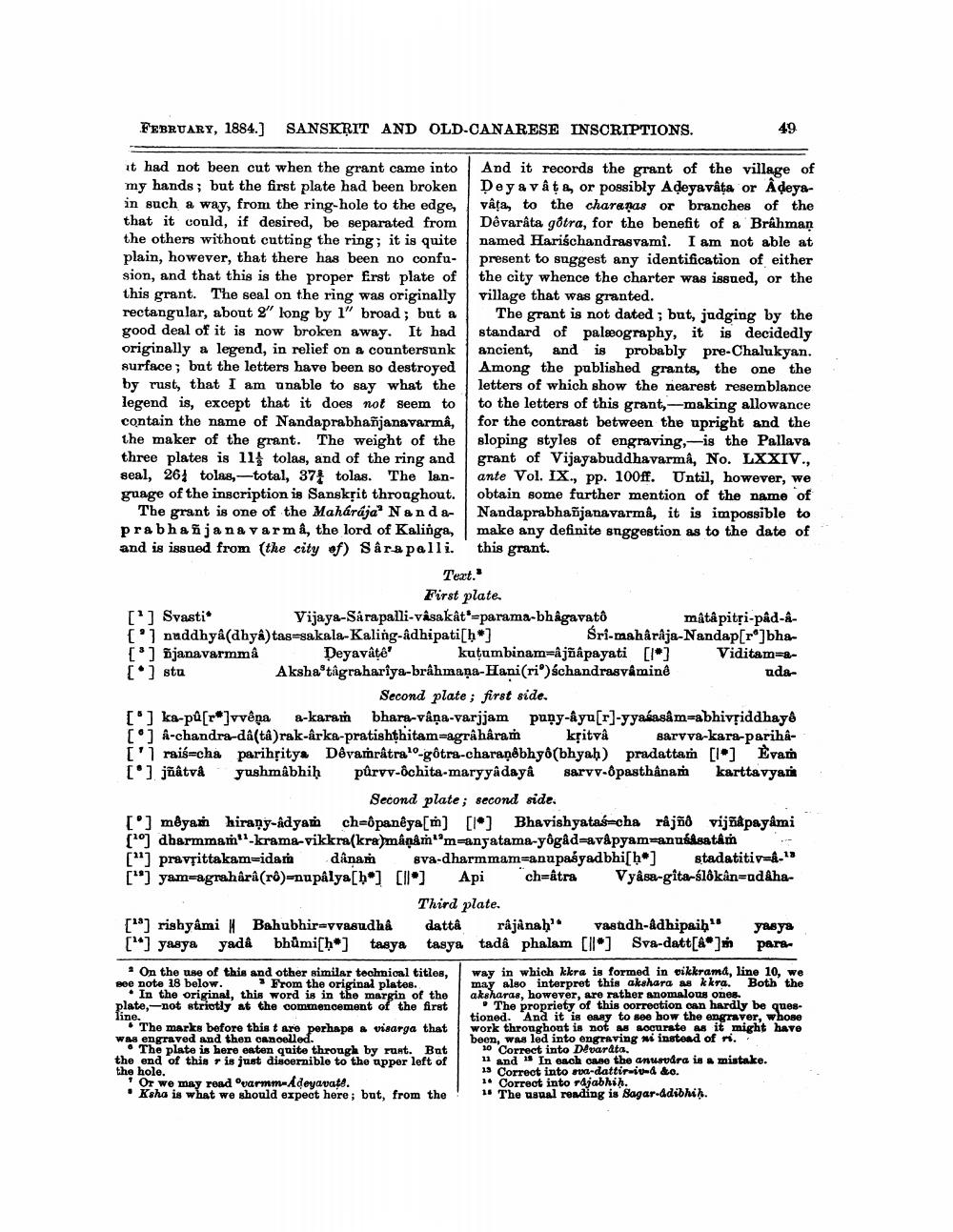________________
FEBRUARY, 1884.) SANSKRIT AND OLD-CANARESE INSCRIPTIONS.
49
it had not been cut when the grant came into And it records the grant of the village of my hands; but the first plate had been broken Deya vât, or possibly Adeyaváta or Adeyain such a way, from the ring-hole to the edge, vâta, to the charaņas or branches of the that it could, if desired, be separated from Dêvarata gôtra, for the benefit of a Brahman the others without cutting the ring; it is quite named Harischandrasvami. I am not able at plain, however, that there has been no confu- present to suggest any identification of either sion, and that this is the proper first plate of the city whence the charter was issued, or the this grant. The seal on the ring was originally village that was granted. rectangular, about 2' long by 1" broad; but a The grant is not dated; but, judging by the good deal of it is now broken away. It had standard of palæography, it is decidedly originally a legend, in relief on a countersunk 1 ancient, and is probably pre-Chalukyan. surface; but the letters have been so destroyed Among the published grants, the one the by rust, that I am unable to say what the letters of which show the nearest resemblance legend is, except that it does not seem to to the letters of this grant,-making allowance contain the name of Nandaprabhañjanavarma, for the contrast between the upright and the the maker of the grant. The weight of the sloping styles of engraving,-is the Pallava three plates is 114 tolas, and of the ring and grant of Vijayabuddhavarma, No. LXXIV., seal, 261 tolas,-total, 371 tolas. The lan- ante Vol. IX., pp. 100ff. Until, however, we guage of the inscription is Sanskrit throughout. obtain some further mention of the name of
The grant is one of the Maharaja' Nenda- Nandaprabhañjanavarma, it is impossible to prabhañjana varma, the lord of Kalinga, make any definite anggestion as to the date of and is issued from (the city of) Sâra palli. this grant.
Text."
First plate. [°] Svasti
Vijaya-Skrapalli-vasakât'-parama-bhagavató mâtâpitri-pâd-&['] nuddhyâ(dhya) tas-sakala-Kaling-adhipati[h*)
Śri-mahârâja-Nandap[ro]bha[°] ñjanavarmmâ Deyavâte' kutumbinam=&jõâpayati [1] Viditam=[ ] stu Akshatîgrahariya-brâhmaņa-Hani(ri)schandrasvåminê
u da Second plate ; first side. [°] ka-pů [r*]vvêņa a-karam bhara-vâņa-varjjam punyâya[r]-yyasasâm=abhivșiddhaya [°] A-chandra-da(ta)rak-arka-pratishthitam-agrâhâra kritvå sarvva-kara-pariha[' raischa parihțitya Devamratra"'-gôtra-charaņēbhyo bhyah) pradattam [lo] Evan [] jõâtvå yushmabhiḥ půryv-ochita-maryyâdaya sarvv-pasthânam kartta vyari
Second plate; second side. [°] mêyan hiraṇy-âdyan ch=ôpanêya[m] [l*) Bhavishyatasacha râjñð vijñ&payâmi [1] dharmmam"-krama-vikkra(kramanam'mangatama-yôgåd=avâpyam=anuáasatam .["] pravșittakam-idam danaṁ sva-dharmmam=anupasyadbhi[ho] stadatitiv-a-13 [") yam-agrahûrâ(rô)-nupâlya[b] [ll] Api ch=âtra Vyâsa-gita-ślôkân=addha
Third plate. [8] rishyami # Bahubhir=vvasudha dattâ râjânah vastdh-adhipaih" yasya [**] yasya yada bhůmich) tasya tasya tada phalam [ll] Sva-datt[& pare
- On the use of this and other similar technical titles, Bee note 18 below.
From the original plates. • In the original, this word is in the margin of the plate, -not strictly at the commencement of the first line.
The marks before this t are perhaps & visarga that was engraved and then cancelled. ... The plate is here eaten quite through by runt. But the end of this is just discernible to the upper left of the hole.
Or we may read "varmm-Adeyavate. • Ksha is what we should expect here; but, from the
way in which kkra is formed in cikkrama, line 10, we may also interpret this akshara as kkra. Both the aksharas, however, are rather anomalous ones.
The propriety of this correction can hardly be ques. tioned. And it is easy to see how the engraver, whose work thronghout is not as socurate as it might have been, was led into engraving wi instead of ri.
10 Correct into Devarata. 11 and 1 In each case the anusvira is a mistake. 13 Correct into ma-dattir-iv-d &o. 1. Correct into rdjabhih.
ing is Sagar-Adibhim.




